In recent years, the number of trademark applications in China has been rising rapidly. In 2019, the total number of trademark applications reached 7.837 million, the total number of registered trademarks was 6.406 million, and 2.5219 million applications were filed by Chinese applicants. By the end of 2019, the total number of effective registered trademark was 25.219 million. Due to the limited trademark resources, the proportion of trademarks rejected in the application stage on the ground that it is identical with or similar to the prior cited trademark is ever higher. In such context, the coexistence agreement is used more and more widely in the appeal of trademark refusal cases. I would like to share my experience and understanding from respects of general situation of trademark coexistence system in different countries, current basic situation of the trademark coexistence in China as well as the application of coexistence agreement in Chinese trademark practice in the hope that it would be informative and helpful for readers.
I. Brief Introduction of Trademark Coexistence System in Different Country
WIPO pointed out in its report that “trademark coexistence describes a situation in which two different enterprises use a similar or identical trademark to market a product or service without necessarily interfering with each other’s businesses.”
At present, the use of trademark co-existence system is not the same all over the world. I think it can be roughly divided into the following three categories:
A. Fully accepted or nearly fully accepted
Including EU, the UK, New Zealand, India, Hungary, etc. For instance:
1. EU
DIRECTIVE 2008/95/EC OF THE EUROPEAN PARLIAMENT AND OF THECOUNCIL (hereinafter referred as to “DIRECTIVE 2008”) prescribed the trademark coexistence agreement, where Article 5 provides that “under such situation, member states may approve the trademark registration or may not announce it invalid: where the right owner of prior trademark or other prior right owner consents to the registration of trademark applied later”.
EUIPO does not conduct substantial examination on the relative grounds for trademark registration; therefore there is no procedure to submit the coexistence agreement to EUIPO. However, EUIPO prescribes that the parties may seek for settlement through negotiation. Hence coexistence agreement is one of the peaceful dispute resolutions in trademark opposition proceeding.
2. The UK
The UK holds an absolute unconditional attitude towards the effectiveness of consent letter in the examination practice of trademark similarity determination. The paragraph 5 of Section 5 of 1994 the UK Trademark Law prescribed that nothing in this section prevents the registration of a trade mark where the proprietor of the earlier trade mark or other earlier right consents to the registration. This means the prior owner’s consent is more effective and will remove all the obstacles provided for in Section 5, including even the circumstance of identical trademark on identical goods or services.
In addition, since the UK doesn’t conduct substantial examination on the relative grounds for trademark registration, there is no procedure of submitting the coexistence agreement to the Intellectual Property Office. Apart from being used as an approach for parties to address the dispute friendly in the opposition proceeding, the effective coexistence agreement (obtained from the other party in advance) could also serve as an effective defense against the invalidation (Section 47 of UK Trademark Law).
B. Conditionally Accepted
Including the United States, China, Taiwan, Hong Kong, Vietnam, Singapore, Malaysia, Canada, Mexico, Brazil, Sweden, Russia and other countries and regions. For instance:
1. The US
It is prescribed in the Trademark Manual of Examining Procedure (TMEP), according to U.S.C. §1052(d) (3), a trademark shall not be registered if it consists of or comprises a
mark which so resembles a
mark registered in the Patent and
Trademark Office, as to be likely, when used on or in connection with the goods of the
applicant, to cause confusion. Where the Patent and
Trademark Office holds no confusion would be caused by more than one person’s continuous use of the same or similar marks under conditions and limitations as to the mode or place of use of the marks or the goods on or in connection with which such marks are used, such trademarks may be concurrently registered. Use prior to the filing date of any pending application or a registration shall not be required when the owner of such application or registration consents to the grant of a concurrent registration to the applicant. Concurrent registrations may also be issued by the Director when a court of competent jurisdiction has finally determined that more than one person is entitled to use the same or similar marks in commerce. In issuing concurrent registrations, the Director shall prescribe conditions and limitations as to the mode or place of use of the mark or the goods on or in connection with which such mark is registered to the respective persons.
According to the US trademark law, generally the patent and trademark office would not allow registration of a trademark that is identical with or similar to a prior trademark, unless the parties applying for trademark coexistence. Moreover, the patent and trademark office shall judge the effectiveness of the coexistence agreement, taking account the following factors as the specific use manner and region of each trademark, whether there is restriction on the goods, and whether it is likely to cause confusion among the consumers.
2. Singapore
According to the item (b)(i) of 7 of chapter 7 of the Trade Marks Work Manual in Singapore, the Registrar may give considerable weight to a letter of consent from the cited owner. The Registrar has the discretion to accept an application under the provisions of Section 8(9) of Trade Marks Act, and judge whether public confusion is likely to be caused. However, each case must be considered on its merits and it is unlikely that a letter of consent alone would justify the withdrawal of a citation where the trademarks are substantially identical, the goods or services the same and the trademarks are to be used in the same markets. If the letter of consent is accepted, it should be stated in the Gazette that the trademark is granted based on the consent of the cited owner.
C. Probably accepted in future
including Japan, Korea and other countries. For instance:
1. Japan
So far there is no express rule about coexistence agreement in Japan. In practice, the so called “assign back” approach is often used when the trademark application is rejected due to the prior registered trademark of others. The applicant may negotiate with the prior trademark owner, and transfer his applied trademark to the prior trademark owner upon receiving the consent of the prior trademark owner. Since there is no right conflict at this moment, the trademark application shall be granted. Then, after the approval of the trademark registration, the prior trademark owner retransfers the trademark to the original applicant. At this point, the applied trademark and the prior trademark achieve the status of coexistence.
Japan has been studying the possibility of introducing the “coexistence agreement” to its legal system, but so far there hasn’t been a conclusion. In current practice, if there is a holding relationship between the trademark applicant and cited mark owner, and the applicant can provide the relevant evidence that the cited mark owner agrees to the registration of the applied mark, such circumstance is not considered belonging to the situation where the registration is prohibited prescribed in item 11 of paragraph 1 of Article 4 of the Japanese Trademark Law, thus the registration should be approved. The trademarks that are granted through this way shall be publicized in the homepage of the patent office. Although coexistence agreement is accepted at present only under the situation that there is a holding relationship between the trademark applicant and the cited mark owner, it is a small step forward on the road of coexistence agreement system.
2. Korea
Till now, there is no express rule about coexistence agreement in Korean law. As early as November 2013, the comprehensive amendment of trademark law once included the proposal of coexistence agreement system, but it was not adopted. Under current trademark practice, the coexistence agreement is not adopted. Generally speaking, in order to have the applied mark coexist with the cited mark, the approach of “assign back” is adopted.
II. Basic situation of trademark coexistence in China at present
A. Basic definition
So far Chinese Trademark Law has not clearly given definition to trademark coexistence, and trademark coexistence is conditionally accepted in China as in the United States and Singapore. However the concept of trademark co-existence has already exploited in the following rules, regulations and judicial interpretations.
1. It is prescribed in the paragraph 3, Article 59 of Chinese Trademark Law that
Where, before a trademark registrant applies for the registration of a trademark, another person has used a trademark that is identical with or similar to the registered trademark in respect of identical or similar goods and has a certain influence, the proprietor of the exclusive right to use the registered trademark shall have no right to prohibit the person to continue to use the said trademark within the original scope. However, the proprietor of the exclusive right to use the registered trademark may require the other person to add a proper distinguishable sign on his goods. That is to say, the law allows coexistence of a trademark that is used earlier.
2. Article 8 of Trademark Adjudication Rules provides that
during the procedure of trademark adjudication, the parties have the right to dispose of their trademark rights and rights related to trademark adjudication in accordance with law. On the premise that no public interest and the rights of third parties would be harmed, the parties may reach a settlement by themselves or through mediation in written forms. This means that the parties are allowed to deal with their private rights in accordance with law, and reach a settlement agreement by themselves.
3. It is prescribed in the Article 1 of
Several Issues Concerning the Trials of the Administrative Litigation Cases Regarding Trademark Granting and Verification By the Supreme People’s Court released on April 20, 2010 that “
with regard to the trademark in dispute that has been used for a long time and has built a reputation and formed relevant public, the legislative spirit of trademark law balancing the interest of prior business signs and maintaining the market order should be taken into consideration, the fact that relevant public has been able to distinguish the relevant business signs should be fully respected, and the stable market order that has been formed should be maintained.” Coexistence of similar trademarks which have been formed due to specific historical conditions is allowed.
B. Practice
So far, the coexistence agreements have been widely used in practice in China. On the 24
th session of the Trademark Appeal Board held on Oct. 16th, 2007, the issue of “coexistence agreement” in the appeal of refusal cases was discussed and an article
Trademark Appeal Board’s studies on the coexistence agreement involved in the appeal cases was published on the Volume 7 of Legal Press (Volume 30 in total) in November, 2007, where it was pointed out that when deciding whether the coexistence should be approved, if the applicant and the cited mark owner have reached a coexistence agreement, eliminating the conflicts between the parties, and it has been shown that the two parties will not be “free riding” each other in actual use, it can be determined that the parties are of good faith in distinguishing the trademarks. However, protecting the interests of consumers is also the purpose of the Chinese Trademark Law, when deciding whether the coexistence should be allowed, the similarity of the goods used by the two parties, the similarity of the two parties' trademarks, and their respective popularity should also be taken into consideration. Even if the goods belong to the similar class but the degree of similarity remains low, the trademarks themselves are similar but distinguishable for consumers as a whole, and then the coexistence may be approved. If the cited mark however enjoys a high popularity, approving the trademark application and use is likely to cause confusion among the consumers, then the application should be rejected. If the trademark has been used and has certain popularity, consumers are capable of distinguishing it from the cited mark, the registration may be approved.
In July 2018, the civil court No. 3 of Beijing High People’s Court issued an article
Several Noteworthy Legal Issues Concerning Current IP Trials (2018) put forward its guiding opinion on the issue of “coexistence agreement” involved in IP trial practice and whether “coexistence agreement” and “consent letter” could serve as the direct evidence to exclude the “possibility of confusion” .
The “attributes of coexistence agreement, formal prerequisites of coexistence agreement and legal effects of coexistence agreement” are expressly prescribed in the paragraph 10 to paragraph 12 in chapter 15 in
Beijing Higher People’s Court Guidelines for the Trial of Trademark Right Granting and Verification Cases released on April, 2019. In the Guidelines, the attribute conclusion of "coexistence agreement can be used as preliminary evidence to eliminate confusion" is made clear. Meanwhile, it also made the following restriction on the legal effect of coexistence agreement:
Under the circumstance that the applied mark is identical with or substantially identical with the cited mark, and both marks are used on the identical or similar goods, the application shall not be approved based on coexistence agreement alone. Under the circumstance that the applied mark is similar to the cited mark, and both marks are used on the identical or similar goods, and the owner of the cited mark issues a coexistence agreement, in the event that there is no any other evidence to prove that the coexistence of two trademarks above is sufficient to make the relevant public confusing the sources of goods, then these two trademarks may be determined to be dissimilar with each other.
In conclusion, coexistence agreement or consent letter has been accepted by examiners or judges and widely used in practice. In the appeal of refusal cases, coexistence agreement or consent letter become one of the important approaches to overcome rejection ground. In general, despite the similarity between the trademark in dispute and the cited mark, as long as they are distinguishable in overall appearance by the consumers and there are certain differences in their designated goods or services, the coexistence agreement or consent letter is likely to be accepted as prima facie evidence to exclude confusion.
III. Analysis on the basic situation of trademark coexistence in Chinese trademark practice
A. Statistics and analysis of recent cases examined and completed by the Trademark Appeal Board
1. Basic statistics and analysis
According to incomplete statistics, by the end of 2018, the number of cases involving "coexistence agreement" or "consent letter" examined and completed by the Trademark Appeal Board reached 8623. Among them, 3,050 applications were approved, 1,602 applications were partly approved, and 3,971 were rejected. Moreover, the author found in the past five years, the support rate of the Trademark Appeal Board remained above 50% in the cases involving “coexistence agreement” or “consent letter”.
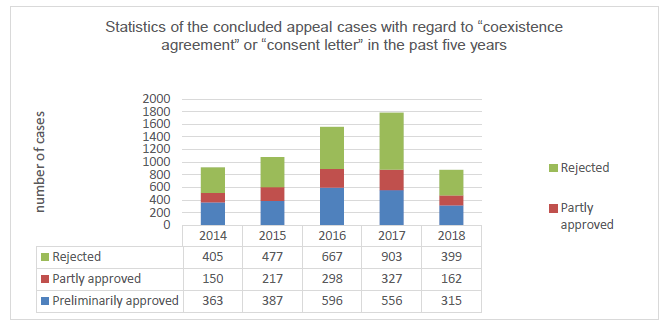
2. List of some appeal cases
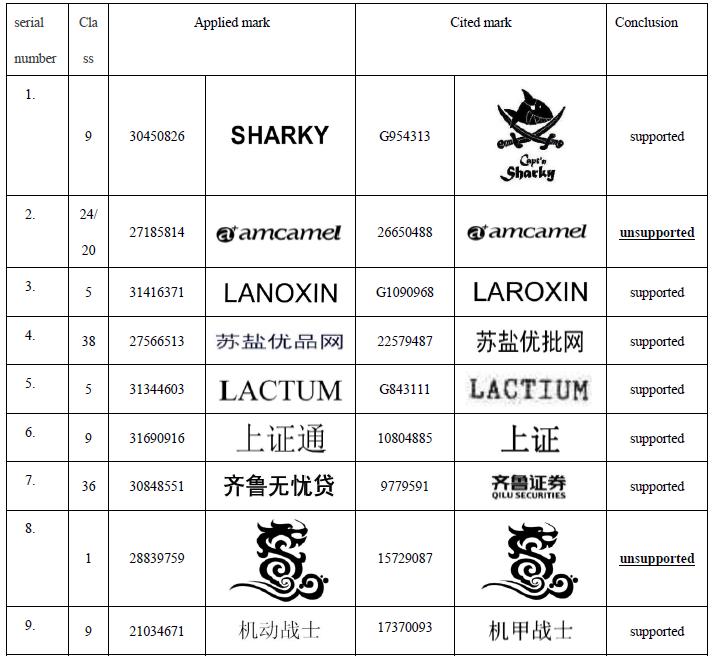
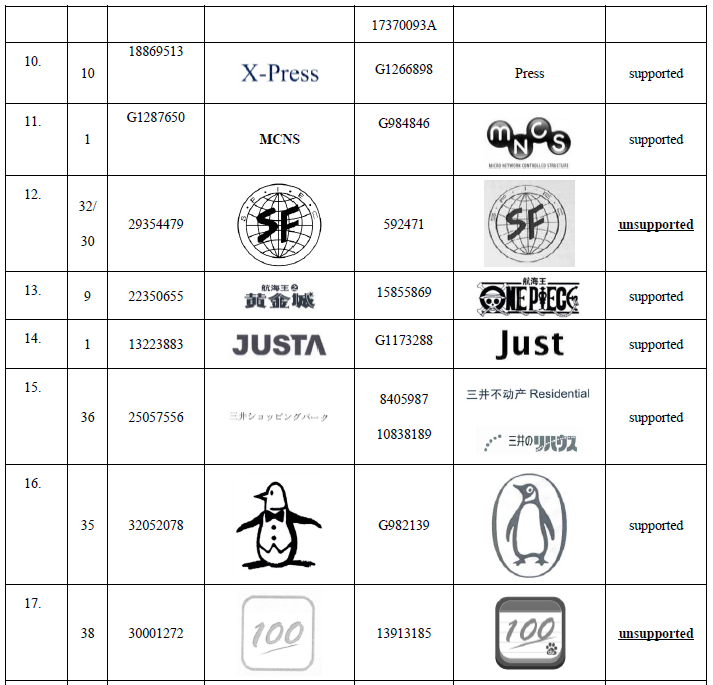

In case retrieval, the author found that the Board does not support the coexistence agreement or consent letter, usually involving the following two situations
1. The applied trademark and the cited trademark are identical or substantially identical. The examiner holds that coexistence of the two trademarks is like to cause confusion and misunderstanding of the origin of the goods among the relevant public.
2. The applicant claimed an intention to negotiate coexistence of the trademarks with the cited mark owner when filing with the appeal. However, up to the time of the examination, the legal and effective documentary evidence that the cited mark owner agrees to the coexistence of the applied mark and the cited mark on the designated goods or services.
To sum up, , consent letter or coexistence agreement has been widely used in the appeal of refusal cases. As long as two trademarks have certain differences, and there is no other evidence to prove that it will cause confusion or misunderstanding among the consumers, the possibility of consent letter or coexistence agreement being accepted is high. Submitting consent letter or coexistence agreement has become one of the effective strategies to overcome the refusal ground.
B. Statistic and some cases concerning coexistence agreement or consent letter involved in judicial precedents
So far in judicial proceedings, the precedents in which coexistence agreement or consent letter was submitted to overcome the obstacle of cited mark is also increasing year by year, and it also becomes one of the effective strategies to overcome the refusal ground. The author took IP HOUSE as the data source and searched out 272 judgements involving trademark coexistence made by Beijing First Intermediate People's Court, Beijing Intellectual Property Court, Beijing High People’s court and the Supreme People’s Court, and selected 74 cases among them to conduct further research and analysis. The details are as follows:
1. Basic situation of the litigation cases involving coexistence agreement or consent letter
As shown in the below chart, in the five years from 2008 to 2013, "coexistence agreement" and "consent" were submitted in only 30 litigation cases. However, it increased to 25 in 2014, surged to 45 and above each year from 2015 to 2017, and peaked at 68 in 2018. It can be seen that with the rapid growth of the number of registered trademarks in China, the demand for trademark coexistence is also growing.
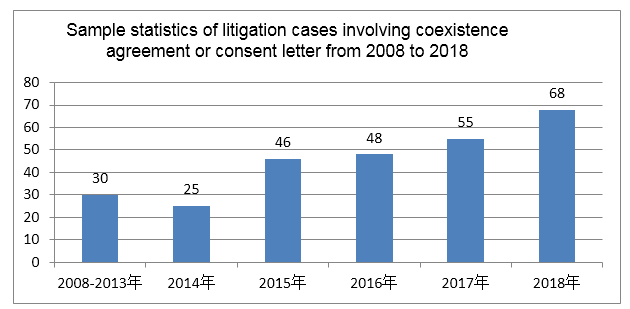
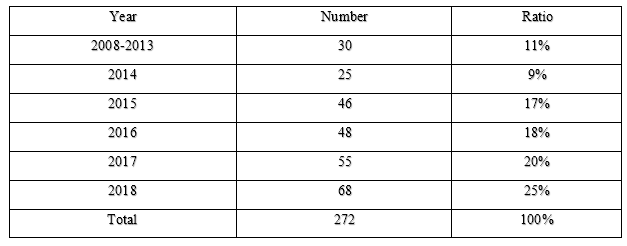
2. Analysis on the parties involved in the coexistence agreement or consent letter
Among the 74 trademark administrative litigation cases researched by the author, enterprises from 22 countries or regions, including United States, Germany, China, Japan, Singapore, France, United Kingdom, Netherlands, Hong Kong, Switzerland, Australia, United Arab Emirates, New Zealand, Taiwan, Italy, Norway, Denmark, Philippines, Liechtenstein, Luxembourg, Northern Ireland, South Korea, etc., presented as a party applying for or issuing coexistence agreement or consent letter, and who made a request for coexistence or responded to such a request. Among these countries and regions, the United States, Germany and Japan are the three countries with the largest number of foreign enterprises being involved in the cases. From 2008 to 2015, Chinese enterprises hardly appeared as parties. However, since 2016, the demand of Chinese enterprises has gradually increased. As of 2018, in the 74 cases researched by the author, the number of Chinese enterprises as a party has reached 20 times. It can be seen that the demand for trademark coexistence of Chinese enterprises is also growing significantly.
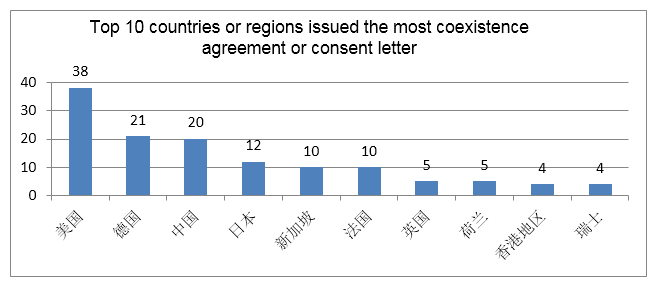
 3.
3. Trend of the judgement on coexistence agreement or consent letter in judicial trial based on some precedents

As shown in the table above, from 2008 to 2012, the judicial organs basically held a negative attitude towards the coexistence agreement in the trial. Since 2013, the co-existence agreement has been gradually recognized in individual cases, and reached its peak in 2014 with basically a situation of being fully recognized. Since then, as the number of cases has gradually increased, and each case differs from the other, disagreements have begun to emerge, but the cases in which coexistence agreement being recognized still accounted for more than 60% of all the cases.
4. List and analysis of some judicial cases
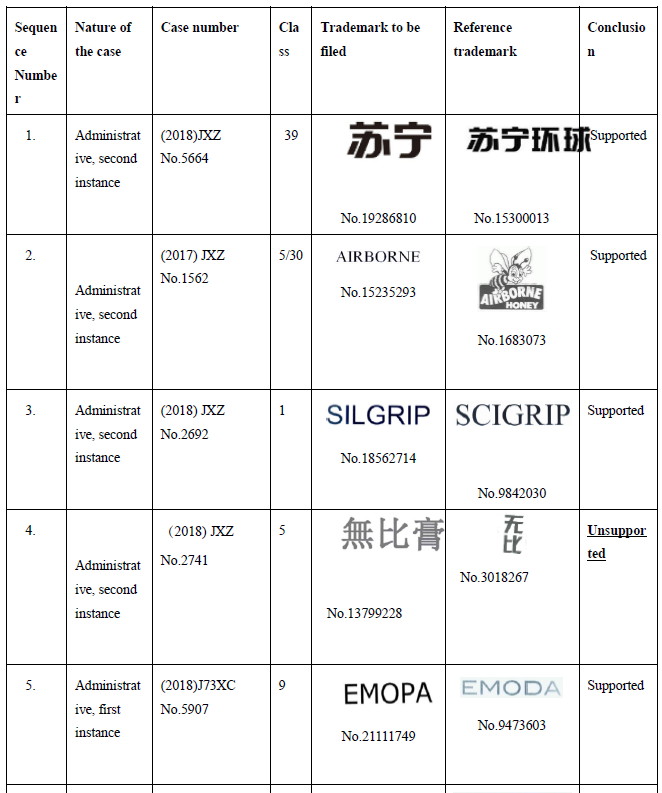
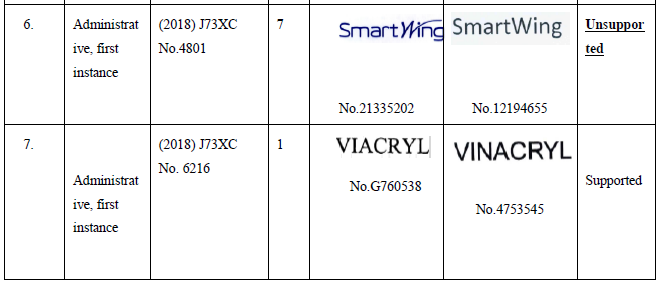
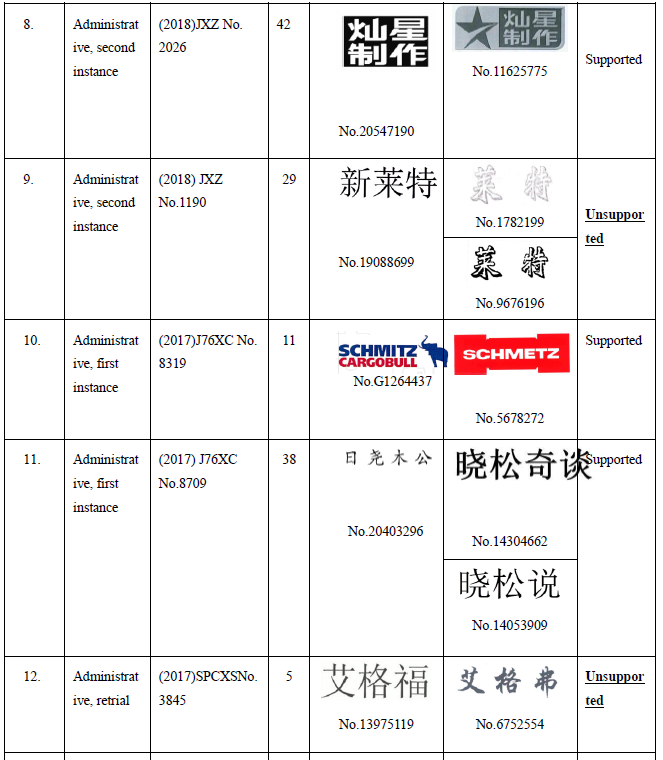
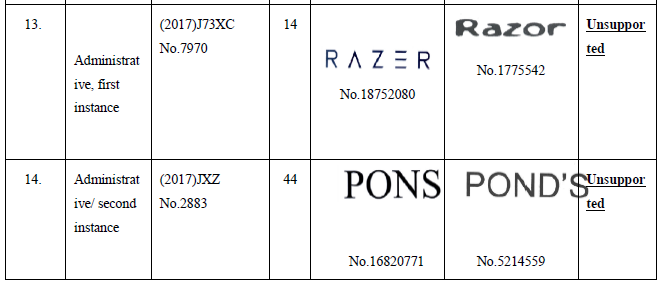
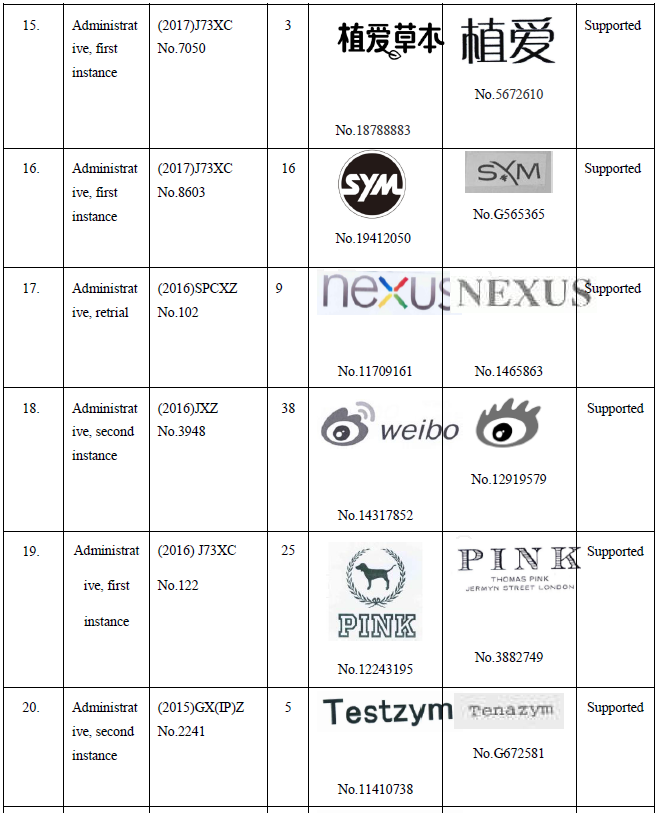
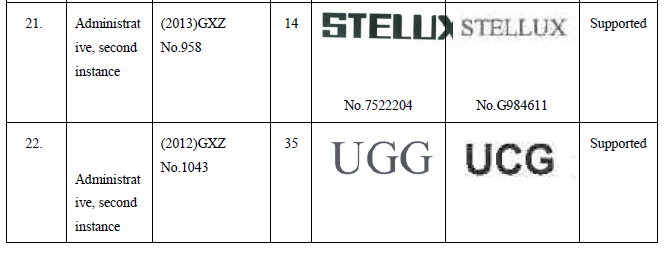

Based on the cases searched out by the author, the main views of supporting trademark coexistence agreement or consent letter in judicial trial are as follows:
4.1. The right owner’s disposition of right should be fully respected
In the case of Lianwu (Beijing) Film and Culture Company’s trademark No. 20403296
“  ”
”, the following opinion was expressed in the judgment of the first instance: for trademark application and registration, the judgement on the possibility of confusion is a presumption made by the administrative trademark granting authority or people’s court in accordance with Article 30 of Trademark Law from the perspective of the relevant public. The "consent letter" in this case is an agreement reached between the trademark applicant and the prior trademark owner of a direct interest whose judgment on whether there may be confusion is more in line with market reality. A trademark right is a civil property right. According to the principle of autonomy of the will, unless major public interest is involved, the trademark owner may dispose his rights based on his own will. The "consent letter" in this case is the prior trademark owner's expression of the intention that the prior owner agrees to the coexistence of the similar marks on the identical or similar services after the negotiation between trademark applicant and the prior trademark owner. Therefore, if there is no obvious fact indicating the possibility of confusion caused by the coexistence of trademark in dispute and the cited mark, and there is no evidence that the consent letter violates laws, administrative regulations or is injurious to the public interest, then the cited mark owner's disposition of his right trademark and his attitude towards registration of the trademark in dispute should be fully respected
[1].
In the appeal of refusal case of Google's trademark“

”No. 11709161, the Supreme People’s Court expressed the following opinion in its judgment: in this case, compared with the ordinary consumers’ interests that are not for sure being damaged, the registration and use of the trademark in dispute would exert more direct and realistic impact on the interests of the cited mark owner, Shimano Inc. issued a written consent expressly agreeing to Google’s application and use of the relevant trademark rights, including the applied mark, which indicated that Shimano Inc. held a negative or tolerant attitude towards whether the registration of the applied mark is likely to cause confusion among the relevant public. In particular, considering that Google and Shimano are well-known enterprises in relevant fields respectively, there is no evidence in this case to prove Google has malice in free-riding the popularity of Shimano’s cited mark when applying for and using the trademark, and there is also no evidence to prove the registration of the applied mark would harm the national interest or the public interest. In the absence of objective evidence, it is inappropriate to simply deny the decision and disposition of the cited mark owner as a producer and business operator on his legitimate rights and interests, and ignore the consent letter issued by the cited mark owner only on the basis of the uncertain "damage to the interests of consumers"
[2].
4.2. The coexistence agreement should be an important basis for the judgement on the similarity of trademarks, except for applying for identical trademarks on identical goods or services
In the appeal of refusal case of the trademark "DynamiQ" No. 1362718 of Koninklijke Philips Electronics N.V., it is stated in the judgment of the first instance: when determining whether trademarks and goods are similar or not, the opinions of the prior trademark owner shall be fully considered and respected. In addition to applying for the registration of identical trademarks on identical goods or services, in order to avoid the parties to circumvent the trademark exclusive right system stipulated by the trademark law through the form of coexistence agreement, and thus not considering the trademark coexistence agreement, for the registration application of similar trademarks on identical or similar goods or services, the coexistence agreement should be used as an important basis for the judgement on the similarity of trademarks. Where the prior trademark owner believes that the trademark sign applied for registration later will not cause confusion or misunderstanding, or allows similar trademarks to be applied for registration on the identical or similar goods or services, it is generally inappropriate to determine that the two trademarks constitute similar trademarks
[3].
At the same time, the author also found the following views are involved in the judicial trial that do not support the coexistence agreement or consent letter:
5.1. Being injurious to the public interest
In the appeal of refusal case of the trademark“

”No. 13975119 of Jinan Ai’gefu Industrial Co., Ltd., the Supreme People’s Court expressed the following opinion in its judgment: Although the coexistence agreement or consent letter between the trademark applicant and the right holder of the cited mark owner belongs to disposition of private rights and should be respected, the precondition is that the national interests, public interests, and the third party's legitimate rights and interests should not be harmed. In this case, since both the applied trademark and the cited trademark are used on the chemical preparations as preparations for destroying noxious animals, preparations for destroying noxious plants, soil-sterilizing preparations, agricultural fungicides, etc., which are closely related to agricultural production and ecological environment, the coexistence of two similar marks are likely to damage the public interest. Therefore, the "trademark coexistence agreement" submitted by Jinan Aigefu Company cannot be a sufficient reason for the registration of the applied mark
[4].
5.2. Possibility of confusion and misunderstanding among the consumers
In the appeal of refusal case of the trademark
“新莱特”No. 19088699 of Synlait Milk Limited, the following opinions were expressed in the judgment of the second instance: The consent letter is a factor in consideration of confusion according to Article 30 of the Trademark Law. In this case, although Synlait Milk Limited submitted a notarized and legalized trademark coexistence agreement, the similarity between the trademark in dispute and the two cited trademarks is relatively high. Moreover, some of the goods of the applied mark requested for appeal are identical with those of the two cited trademarks. Therefore, there is a greater possibility of confusion and misidentification caused due to the coexistence of the trademark in dispute and the two trademarks. Although Bright Dairy Co., Ltd. agrees in the trademark coexistence agreement that the relevant public of Synlait Milk Limited is completely different from that of Bright Dairy Co., Ltd., according to the evidence on record submitted by Synlait, Synlait is a subsidiary of Bright Dairy Co., Ltd., and their business scope overlapped. In the absence of full explanation and clear agreement on the business scope and market segmentation in trademark coexistence agreement, the above-mentioned consent letter alone is insufficient to exclude the possibility of confusion caused by the coexistence of the above trademarks
[5].
In the appeal of refusal case of the trademark
“ ”
”No. 13799228 of Ikeda Mohando Co., Ltd., the following views were expressed in the judgement of second instance: Although Ikeda Mohando Co., Ltd. submitted a consent letter signed by the cited trademark owner during the trial of this litigation, the coexistence consent letter can only be used as
prima facie evidence to eliminate the possibility of confusion, it is also necessary to consider the factors such as the degree of similarity between the two trademarks, the class of the designated goods, and whether the coexistence will affect the public interest, etc.. Due to the high degree of similarity between the trademark in dispute and the cited mark, and the goods designated for use are human medicines, the agreement between the right holders alone is not enough to exclude the possibility of confusion and misidentification among the relevant public
[6].
5.3. Increase consumer identification costs
In the appeal of refusal case of the trademark
“
” No. 18752080 of Razer (Asia Pacific) Pte. Ltd., the following opinions were expressed in the judgment of the first instance: Trademark differentiation stipulated by law is not only for the protection of prior trademark rights, but also for the public interests. Trademark differentiation can enable consumers to quickly identify the source of production and establish consumer preferences. However, if similar trademarks representing different sources and qualities are allowed to coexist, it will inevitably increase the cost of identification of consumers, and even make consumers misidentify the source and purchase mistakenly, thus damaging consumers' legitimate interests. When it is enough to affect the interests of consumers and market order for whether the trademarks can be distinguished, then whether a trademark which cannot be distinguished from prior marks should be registered of course does not depend on the will of the prior trademark owner only. If the goods or services classes designated by the two trademarks are identical or basically identical, and there is no obvious difference in the trademark signs itself, even if the prior trademark owner agrees to coexist, the later trademark registration may not be approved. As mentioned earlier, this will affect the interests of consumers, one of the stakeholders in the coexistence relationship of trademarks
[7].
In the appeal of refusal case of the trademark "CHRONON" No. 22790054 of Siemens Medical Co., Ltd., a similar point of view is reiterated in the judgment of the first instance: Trademark differentiation stipulated by law is not only for the protection of prior trademark rights but also for the public interests. Trademark differentiation can enable consumers to quickly identify the source of production and establish consumer preferences. However, if similar trademarks representing different sources and qualities are allowed to coexist, it will inevitably increase the cost of identification of consumers, and even make consumers to misidentify and purchase mistakenly, which will harm consumers' legitimate interests
[8].
5.4. Flaws in the submitted evidence
In the appeal of refusal case of the trademark “PONS” No. 16820771 of the NEUROHABILITATION Corporation, the following opinions were expressed in the judgment of the second instance: The party shall state the source of the evidence it submitted and formed outside the territory of the People's Republic of China (hereinafter referred to as China). The evidence shall be notarized by the notary office of the country where the evidence is formed, and legalized by the Chinese embassy or consulate in that country, or perform the verification procedures stipulated in the relevant treaty concluded between China and the country where the evidence is obtained. The "Consent letter" submitted by NEUROHABILITATION Corporation, where the cited trademark own agrees to the registration of the trademark in dispute on the designated service, is not admitted since notarization and legalization procedure have not been fulfilled
[9].
Ⅳ. Conclusion
As one of the important intellectual property rights of civil property rights, the trademark right is essentially a private right that can be negotiated on the principle of freedom of contract. The author believes that, in general, in cases of trademark coexistence agreement or consent letter, unless the trademarks are identical, the autonomy of the will of the parties and their disposition of their own rights shall be fully respected. Of course, to protect consumer interests and balance the rights between public and private, a more stringent and cautious attitude should be adopted for trademark coexistence once the public interests such as national health and public environmental safety would be affected. In addition, because the judgment of the possibility of the confusion caused by similar trademark is very complicated, not only the degree of similarity of the trademark itself and the degree of relevance of the approved goods / services are to be considered, other factors such as the popularity of the trademarks of both parties, the public attention, whether the party is of bad faith in actual sales, whether there are other identification signs in the package of a specific product, etc. will be considered. At present, even when making judicial judgments, it is necessary to make a comprehensive judgment based on the evidence provided by both parties. Therefore, in the absence of evidence and the fact that confusion has been caused, the trademark examination authority should not simply predict the possibility of confusion only based on presumption. If the right owner of the cited trademark issues a "coexistence agreement" or "consent letter" where the registration of the disputed trademark is agreed, and there is no other evidence to prove the possibility of confusion or the coexistence will damage the public interest, under such circumstances, the registration of the trademark in dispute should be approved as much as possible, so as to achieve reasonable coexistence of different trademark owners and inclusive development in a huge market.
References:
1. CNIPA (formerly Trademark Appeal Board), Trademark Appeal Board’s studies on the coexistence agreement involved in the appeal cases: Legal Press (Volume 30 in total), April 9, 2009
http://spw.sbj.cnipa.gov.cn/fwtx/200904/t20090409_226883.html
2. The Civil Court No.3 of Beijing Higher People, Several Noteworthy Legal Issues Concerning Current IP Trials (2018)
https://mp.weixin.qq.com/s/o9g5EOgNhUxwldgVXVLq1Q
3. Zhongyang WANG, Are trademark coexistence agreements legal? How is effectiveness determined?: China Trademark Magazine: January 2019
http://www.cha-tm.com:8443/xinwen/html/201901/201901041602472252.html
4. SunBusiness, 2015 Research Report on the Coexistence Agreement System in the Trademark System in the Investigation Report of Japanese Patent Office on Industrial Property Rights System: February 2016
[1] (2017) Jing 73 Administrative First No. 8709
[2] (2016) Supreme Administrative Retiral No. 102
[3] (2019) Jing 73 Administrative First No. 5954
[4] (2017) Supreme Administrative Retiral No. 3845
[5] (2018) Jing Final Administrative No.1190
[6] (2018) Jing Final Administrative No. 2741
[7] (2017) Jing 73 Administrative First 7970
[8] (2018) Jing 73 Administrative First No. 9292
[9] (2017) Jing Final Administrative No. 2883

















 ”, the following opinion was expressed in the judgment of the first instance: for trademark application and registration, the judgement on the possibility of confusion is a presumption made by the administrative trademark granting authority or people’s court in accordance with Article 30 of Trademark Law from the perspective of the relevant public. The "consent letter" in this case is an agreement reached between the trademark applicant and the prior trademark owner of a direct interest whose judgment on whether there may be confusion is more in line with market reality. A trademark right is a civil property right. According to the principle of autonomy of the will, unless major public interest is involved, the trademark owner may dispose his rights based on his own will. The "consent letter" in this case is the prior trademark owner's expression of the intention that the prior owner agrees to the coexistence of the similar marks on the identical or similar services after the negotiation between trademark applicant and the prior trademark owner. Therefore, if there is no obvious fact indicating the possibility of confusion caused by the coexistence of trademark in dispute and the cited mark, and there is no evidence that the consent letter violates laws, administrative regulations or is injurious to the public interest, then the cited mark owner's disposition of his right trademark and his attitude towards registration of the trademark in dispute should be fully respected[1].
”, the following opinion was expressed in the judgment of the first instance: for trademark application and registration, the judgement on the possibility of confusion is a presumption made by the administrative trademark granting authority or people’s court in accordance with Article 30 of Trademark Law from the perspective of the relevant public. The "consent letter" in this case is an agreement reached between the trademark applicant and the prior trademark owner of a direct interest whose judgment on whether there may be confusion is more in line with market reality. A trademark right is a civil property right. According to the principle of autonomy of the will, unless major public interest is involved, the trademark owner may dispose his rights based on his own will. The "consent letter" in this case is the prior trademark owner's expression of the intention that the prior owner agrees to the coexistence of the similar marks on the identical or similar services after the negotiation between trademark applicant and the prior trademark owner. Therefore, if there is no obvious fact indicating the possibility of confusion caused by the coexistence of trademark in dispute and the cited mark, and there is no evidence that the consent letter violates laws, administrative regulations or is injurious to the public interest, then the cited mark owner's disposition of his right trademark and his attitude towards registration of the trademark in dispute should be fully respected[1]. ”No. 11709161, the Supreme People’s Court expressed the following opinion in its judgment: in this case, compared with the ordinary consumers’ interests that are not for sure being damaged, the registration and use of the trademark in dispute would exert more direct and realistic impact on the interests of the cited mark owner, Shimano Inc. issued a written consent expressly agreeing to Google’s application and use of the relevant trademark rights, including the applied mark, which indicated that Shimano Inc. held a negative or tolerant attitude towards whether the registration of the applied mark is likely to cause confusion among the relevant public. In particular, considering that Google and Shimano are well-known enterprises in relevant fields respectively, there is no evidence in this case to prove Google has malice in free-riding the popularity of Shimano’s cited mark when applying for and using the trademark, and there is also no evidence to prove the registration of the applied mark would harm the national interest or the public interest. In the absence of objective evidence, it is inappropriate to simply deny the decision and disposition of the cited mark owner as a producer and business operator on his legitimate rights and interests, and ignore the consent letter issued by the cited mark owner only on the basis of the uncertain "damage to the interests of consumers"[2].
”No. 11709161, the Supreme People’s Court expressed the following opinion in its judgment: in this case, compared with the ordinary consumers’ interests that are not for sure being damaged, the registration and use of the trademark in dispute would exert more direct and realistic impact on the interests of the cited mark owner, Shimano Inc. issued a written consent expressly agreeing to Google’s application and use of the relevant trademark rights, including the applied mark, which indicated that Shimano Inc. held a negative or tolerant attitude towards whether the registration of the applied mark is likely to cause confusion among the relevant public. In particular, considering that Google and Shimano are well-known enterprises in relevant fields respectively, there is no evidence in this case to prove Google has malice in free-riding the popularity of Shimano’s cited mark when applying for and using the trademark, and there is also no evidence to prove the registration of the applied mark would harm the national interest or the public interest. In the absence of objective evidence, it is inappropriate to simply deny the decision and disposition of the cited mark owner as a producer and business operator on his legitimate rights and interests, and ignore the consent letter issued by the cited mark owner only on the basis of the uncertain "damage to the interests of consumers"[2]. ”No. 13975119 of Jinan Ai’gefu Industrial Co., Ltd., the Supreme People’s Court expressed the following opinion in its judgment: Although the coexistence agreement or consent letter between the trademark applicant and the right holder of the cited mark owner belongs to disposition of private rights and should be respected, the precondition is that the national interests, public interests, and the third party's legitimate rights and interests should not be harmed. In this case, since both the applied trademark and the cited trademark are used on the chemical preparations as preparations for destroying noxious animals, preparations for destroying noxious plants, soil-sterilizing preparations, agricultural fungicides, etc., which are closely related to agricultural production and ecological environment, the coexistence of two similar marks are likely to damage the public interest. Therefore, the "trademark coexistence agreement" submitted by Jinan Aigefu Company cannot be a sufficient reason for the registration of the applied mark[4].
”No. 13975119 of Jinan Ai’gefu Industrial Co., Ltd., the Supreme People’s Court expressed the following opinion in its judgment: Although the coexistence agreement or consent letter between the trademark applicant and the right holder of the cited mark owner belongs to disposition of private rights and should be respected, the precondition is that the national interests, public interests, and the third party's legitimate rights and interests should not be harmed. In this case, since both the applied trademark and the cited trademark are used on the chemical preparations as preparations for destroying noxious animals, preparations for destroying noxious plants, soil-sterilizing preparations, agricultural fungicides, etc., which are closely related to agricultural production and ecological environment, the coexistence of two similar marks are likely to damage the public interest. Therefore, the "trademark coexistence agreement" submitted by Jinan Aigefu Company cannot be a sufficient reason for the registration of the applied mark[4]. ”No. 13799228 of Ikeda Mohando Co., Ltd., the following views were expressed in the judgement of second instance: Although Ikeda Mohando Co., Ltd. submitted a consent letter signed by the cited trademark owner during the trial of this litigation, the coexistence consent letter can only be used as prima facie evidence to eliminate the possibility of confusion, it is also necessary to consider the factors such as the degree of similarity between the two trademarks, the class of the designated goods, and whether the coexistence will affect the public interest, etc.. Due to the high degree of similarity between the trademark in dispute and the cited mark, and the goods designated for use are human medicines, the agreement between the right holders alone is not enough to exclude the possibility of confusion and misidentification among the relevant public[6].
”No. 13799228 of Ikeda Mohando Co., Ltd., the following views were expressed in the judgement of second instance: Although Ikeda Mohando Co., Ltd. submitted a consent letter signed by the cited trademark owner during the trial of this litigation, the coexistence consent letter can only be used as prima facie evidence to eliminate the possibility of confusion, it is also necessary to consider the factors such as the degree of similarity between the two trademarks, the class of the designated goods, and whether the coexistence will affect the public interest, etc.. Due to the high degree of similarity between the trademark in dispute and the cited mark, and the goods designated for use are human medicines, the agreement between the right holders alone is not enough to exclude the possibility of confusion and misidentification among the relevant public[6]. ” No. 18752080 of Razer (Asia Pacific) Pte. Ltd., the following opinions were expressed in the judgment of the first instance: Trademark differentiation stipulated by law is not only for the protection of prior trademark rights, but also for the public interests. Trademark differentiation can enable consumers to quickly identify the source of production and establish consumer preferences. However, if similar trademarks representing different sources and qualities are allowed to coexist, it will inevitably increase the cost of identification of consumers, and even make consumers misidentify the source and purchase mistakenly, thus damaging consumers' legitimate interests. When it is enough to affect the interests of consumers and market order for whether the trademarks can be distinguished, then whether a trademark which cannot be distinguished from prior marks should be registered of course does not depend on the will of the prior trademark owner only. If the goods or services classes designated by the two trademarks are identical or basically identical, and there is no obvious difference in the trademark signs itself, even if the prior trademark owner agrees to coexist, the later trademark registration may not be approved. As mentioned earlier, this will affect the interests of consumers, one of the stakeholders in the coexistence relationship of trademarks[7].
” No. 18752080 of Razer (Asia Pacific) Pte. Ltd., the following opinions were expressed in the judgment of the first instance: Trademark differentiation stipulated by law is not only for the protection of prior trademark rights, but also for the public interests. Trademark differentiation can enable consumers to quickly identify the source of production and establish consumer preferences. However, if similar trademarks representing different sources and qualities are allowed to coexist, it will inevitably increase the cost of identification of consumers, and even make consumers misidentify the source and purchase mistakenly, thus damaging consumers' legitimate interests. When it is enough to affect the interests of consumers and market order for whether the trademarks can be distinguished, then whether a trademark which cannot be distinguished from prior marks should be registered of course does not depend on the will of the prior trademark owner only. If the goods or services classes designated by the two trademarks are identical or basically identical, and there is no obvious difference in the trademark signs itself, even if the prior trademark owner agrees to coexist, the later trademark registration may not be approved. As mentioned earlier, this will affect the interests of consumers, one of the stakeholders in the coexistence relationship of trademarks[7].